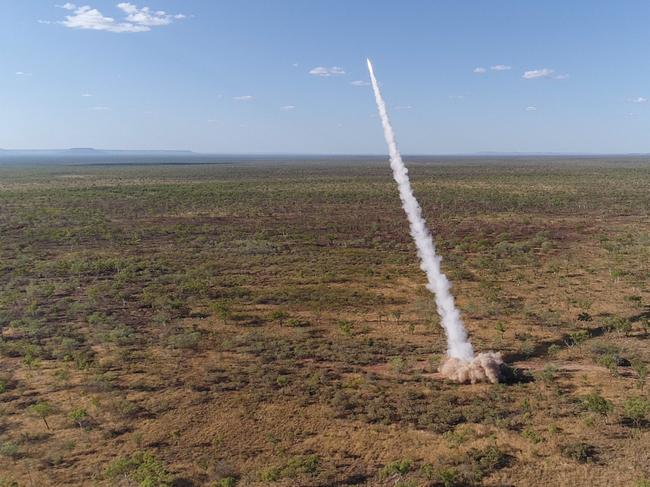Review submission shows Australia within striking distance of Chinese missiles
A dramatic submission to the national Defence Strategic Review has revealed how vulnerable Australia is to Chinese missile strikes.
National
Don't miss out on the headlines from National. Followed categories will be added to My News.
A map war-gaming potential threats from China’s land-based missile arsenal showing strikes across two thirds of Australia forms part of a dramatic submission to the highly anticipated Defence Strategic Review.
The 33-page document put together by former analysts from Defence and the Rand Corporation paints a stark picture as it argues for Australia’s future military bases, stockpiles and fuel depots to push further south.
The report flags the militarisation of artificial reefs and atolls in disputed South China Sea that today allow for the People’s Republic of China (PRC) forces to potentially launch land-based DF-26 intermediate-range ballistic missile strikes.

The analysis specifically nominates the PRC’s militarised Mischief Reef atoll as creating a “ring range” over key ADF facilities in the Northern Territory, Townsville in Queensland and the top half of Western Australia, notably the sensitive joint Australian-US Naval Communication Station Harold E. Holt.
In October US intelligence confirmed Mischief Reef was militarily operational and Guam and America’s “Second Island Chain” Pacific defence strategy were now within PRC threat capability.

It is such a capability threat that will feature heavily in discussions this week in inaugural AUKUS security pact talks in Washington between Australia’s Defence Minister Richard Marles and his US and UK counterparts.

Mr Marles said the meeting would advance the AUKUS agenda, creating opportunities to build the ADF’s military capabilities and through that bolster the country’s defence industry which in turn would boost and integrate the supply chain between the three nations.
He said the AUKUS agenda, which comes on the side of the broader Australia-United States Ministerial Consultations (AUSMIN) talks also involving foreign ministers – come during the “most complex and precarious set of strategic circumstances”.

Speaking to a business forum, Mr Marles said the Indo-Pacific region was the epicentre of geostrategic competition “as we witness the largest military build-up anywhere in the world over the last 70 years”.
He said while AUKUS flagship focus was the Royal Australian Navy’s future acquisition of nuclear-powered submarines from the US and UK, so too were other joint programs and that would require a three way industrial military manufacturing base.

“We must invest in capabilities that enable us to hold potential adversaries’ forces at risk at greater distance and increase the cost of aggression against Australia and its interests,” he said.
The Defence Strategic Review – announced by Mr Marles in August and led by former Australian Defence Force Chief Sir Angus Houston and former Defence Minister Professor Stephen Smith – will determine what the ADF would need to do this.
It is believed it will include some form of defence missile system such as America’s Terminal High Altitude Area Defense (THAAD) antimissile interception system which it has in Guam.
Submissions to the DSR closed last week with a report to be sent to government by February with elements released to the public in March.
More Coverage
Originally published as Review submission shows Australia within striking distance of Chinese missiles




